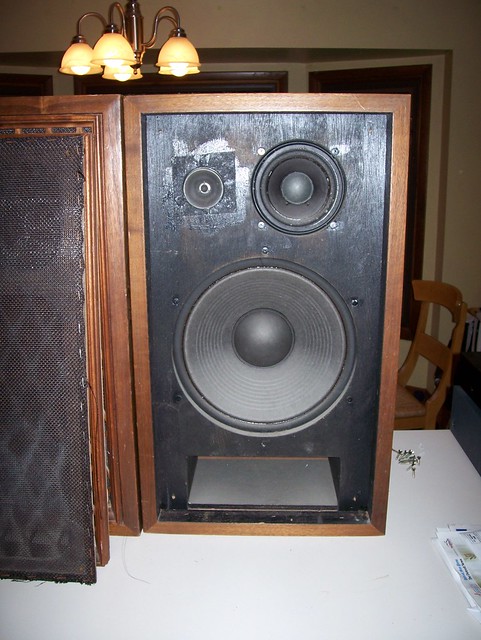VintageVill
New Member
Hello all,
I recently came across this pair of speakers, and I have no idea what they are. They are branded GTR and the model is the R 5000. A google search reveals nothing about this model. The cabinets measure 14" x 8.5" x 26.5". On the back it has no binding posts, rather it is wired directly to the drivers. It's 3 way - 12" Woofer, 5" Mid and 4" Tweeter. I unscrewed the drivers, all of which are Pioneers, and there's no crossover board inside . The speaker wire is wired directly onto the woofers, and then there are wires going off to the tweeter and mid from there, with a single inline capacitor to each. The one going to the tweeter is rated 4.7uf 50V, and the one to the mid is rated 6.8uf 50V. All of the drivers seem to be rated 8 Ohm, but i don't know the wattage of the whole speaker. Sadly the information on the back of the Woofer is pretty much entirely obscured or rubbed off.
. The speaker wire is wired directly onto the woofers, and then there are wires going off to the tweeter and mid from there, with a single inline capacitor to each. The one going to the tweeter is rated 4.7uf 50V, and the one to the mid is rated 6.8uf 50V. All of the drivers seem to be rated 8 Ohm, but i don't know the wattage of the whole speaker. Sadly the information on the back of the Woofer is pretty much entirely obscured or rubbed off.
I took photos of everything in hopes that someone may be able to tell me what I've got and what they're worth.





I recently came across this pair of speakers, and I have no idea what they are. They are branded GTR and the model is the R 5000. A google search reveals nothing about this model. The cabinets measure 14" x 8.5" x 26.5". On the back it has no binding posts, rather it is wired directly to the drivers. It's 3 way - 12" Woofer, 5" Mid and 4" Tweeter. I unscrewed the drivers, all of which are Pioneers, and there's no crossover board inside
 . The speaker wire is wired directly onto the woofers, and then there are wires going off to the tweeter and mid from there, with a single inline capacitor to each. The one going to the tweeter is rated 4.7uf 50V, and the one to the mid is rated 6.8uf 50V. All of the drivers seem to be rated 8 Ohm, but i don't know the wattage of the whole speaker. Sadly the information on the back of the Woofer is pretty much entirely obscured or rubbed off.
. The speaker wire is wired directly onto the woofers, and then there are wires going off to the tweeter and mid from there, with a single inline capacitor to each. The one going to the tweeter is rated 4.7uf 50V, and the one to the mid is rated 6.8uf 50V. All of the drivers seem to be rated 8 Ohm, but i don't know the wattage of the whole speaker. Sadly the information on the back of the Woofer is pretty much entirely obscured or rubbed off. I took photos of everything in hopes that someone may be able to tell me what I've got and what they're worth.











